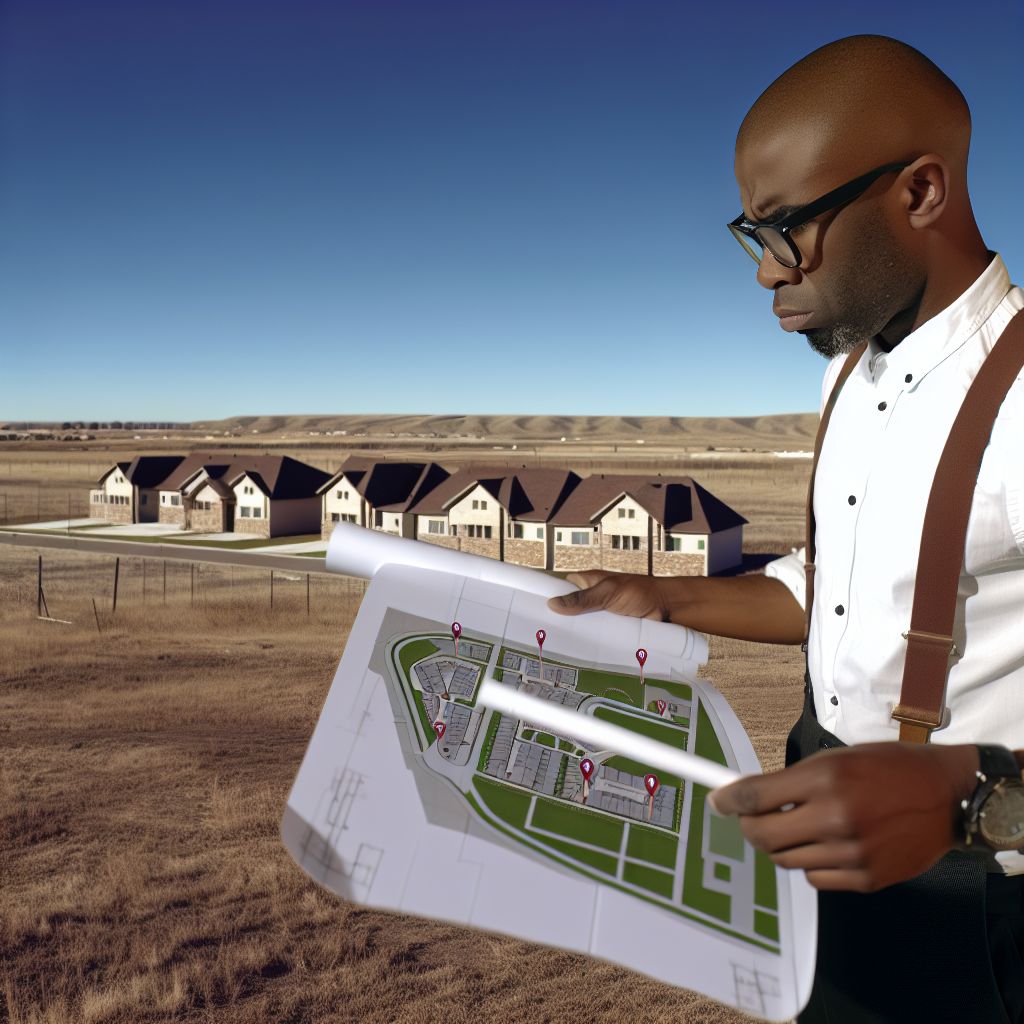Overview of Land Development in the Context of Senior Living Communities
The Importance of Land Development
Land development plays a crucial role in establishing senior living communities.
This process ensures that the needs of seniors are met effectively.
Moreover, it involves creating spaces that promote safety and accessibility.
Proper land development focuses on enhancing the quality of life for residents.
Key Considerations in Land Development
When developing land for senior living, several factors must be considered.
First, location is paramount; it should be close to essential services.
These services may include healthcare facilities, grocery stores, and parks.
Next, zoning regulations must be carefully reviewed and adhered to.
Developers must also consider the availability of public transportation.
This accessibility facilitates independence for senior residents.
Design Elements for Senior Living Communities
Effective design accommodates the unique needs of seniors.
For instance, community layouts should allow for easy navigation.
Walkable paths, ramps, and adequate lighting enhance safety.
Additionally, green spaces and recreational areas promote social interaction.
Some communities incorporate wellness centers and fitness facilities.
Community Involvement and Feedback
Engaging with the community is vital throughout the development process.
Listening to the needs of potential residents shapes better design choices.
Moreover, feedback from seniors ensures their voices are heard.
This involvement fosters a sense of belonging from the outset.
Sustainability in Land Development
Sustainable practices are increasingly essential in land development.
Developers should focus on eco-friendly materials and methods.
Energy-efficient buildings reduce environmental impact and costs.
Furthermore, incorporating sustainable landscapes enhances the community’s appeal.
Ultimately, sustainability supports long-term viability for senior living communities.
Planning for Successful Senior Living Environments
Land development for senior living communities requires careful planning.
Developers must prioritize accessibility, safety, and sustainability.
Doing so allows these communities to flourish and serve residents well.
Market Analysis: Demand for Senior Living Spaces
Growing Population of Seniors
Demographic shifts indicate a rising number of seniors.
By 2030, one in five Americans will be over 65 years old.
This trend significantly increases the demand for senior living spaces.
Changing Preferences in Senior Living
Seniors prefer communities that offer social engagement.
Many opt for lifestyles that prioritize wellness and convenience.
Consequently, developers need to consider these preferences in their projects.
Economic Factors Influencing Demand
The economy significantly impacts senior living options.
As economies improve, families can invest more in their loved ones.
This financial boost drives the construction of more senior living facilities.
Types of Senior Living Options
Various senior living options cater to different needs.
Independent living communities offer autonomy and social opportunities.
Assisted living facilities provide necessary support for daily activities.
Furthermore, memory care units are essential for seniors with cognitive impairments.
Regional Differences in Demand
Regional factors also dictate demand for senior living spaces.
Urban areas often see higher demand due to dense populations.
Conversely, rural regions may offer more affordable options.
Understanding these regional differences is crucial for successful development.
Impact of COVID-19 on Senior Living Preferences
The COVID-19 pandemic has reshaped perceptions about senior living.
Many families now prioritize health and safety in their choices.
Consequently, developers must focus on creating safer environments.
Designs that facilitate social distancing and hygiene are in high demand.
Zoning Regulations and Planning Considerations for Senior Living Developments
Understanding Zoning Regulations
Zoning regulations dictate land use in specific areas.
These regulations determine how land can be developed and utilized.
Local governments create zoning laws to address community needs.
Senior living communities often require specific zoning classifications.
Residential, commercial, and mixed-use zones may be appropriate.
Confirming Appropriate Zoning Classifications
Developers must ensure their projects meet local zoning codes.
Researching city and county regulations is essential.
Compliance with regulations avoids costly delays and modifications.
Consulting with local planning departments can clarify requirements.
Furthermore, zoning classifications can vary widely by location.
Site Planning Considerations
Effective site planning enhances the functionality of senior living communities.
Accessibility is a primary consideration in layout design.
Facilities should be conveniently located for residents.
Walking paths and outdoor spaces enhance mobility and promote wellness.
Developers must also consider privacy and aesthetic appeal.
Assessing Community Impact
Proposed developments should consider their impact on local communities.
Engaging with community members can provide valuable feedback.
Understanding community needs fosters goodwill and support.
Potential traffic increases and resource demands must also be evaluated.
Parking and Transportation Needs
Parking availability plays a critical role in senior living development.
Developers should assess the parking needs of residents and visitors.
Proximity to public transportation enhances community access.
Furthermore, providing shuttle services can improve mobility for seniors.
Future-Proofing Developments
Planning for future trends is vital in senior living developments.
Developers should consider evolving demographic needs.
Adjustments in design may be required to accommodate changing preferences.
Incorporating technology enhances living experiences for residents.
Finally, sustainable design practices can reduce environmental impact.
Delve into the Subject: Collateral Requirements for Commercial Real Estate Loan Approval
Key Design Features that Enhance Senior Living Experience
Accessibility and Mobility
Accessibility is paramount in senior living communities.
Wide hallways and doorways accommodate mobility aids.
Additionally, ramps and elevators ensure easy navigation.
Non-slip flooring enhances safety for residents.
Moreover, well-placed handrails offer support throughout the facility.
Social Interaction Zones
Common areas foster community engagement among residents.
Designing inviting lounges encourages socialization.
Outdoor spaces, such as gardens, enhance interaction.
Activity rooms cater to hobbies and group activities.
Flexible spaces adapt to various events and gatherings.
Comfortable Living Spaces
Private apartments should feel like home for residents.
Thoughtfully designed layouts maximize comfort and functionality.
Natural light streams in through large windows.
Additionally, modern kitchens promote independence in meal preparation.
Private patios or balconies extend personal space outdoors.
Wellness and Healthcare Facilities
On-site healthcare services are essential in senior communities.
Designing wellness centers supports physical and mental health.
Therapy rooms cater to rehabilitation needs effectively.
Additionally, fitness areas encourage regular exercise among residents.
Wellness programs promote healthy lifestyle choices for all.
Safety and Security Measures
Safety is a top priority in senior living design.
Emergency call systems provide peace of mind to residents.
Secure entry points control access to the community.
Regular safety drills prepare residents for emergencies.
Surveillance systems enhance security throughout the property.
Sustainable Design Practices
Sustainable practices benefit both residents and the environment.
Energy-efficient systems reduce utility costs and impact.
Use of environmentally-friendly materials promotes health.
Outdoor spaces that incorporate local flora enhance aesthetics.
Effective waste management practices support sustainability efforts.
Gain More Insights: Retail Property Due Diligence Checklist for Commercial Investors
Sustainability Practices in Land Development for Senior Living
Emphasizing Green Building Techniques
Green building techniques are vital in senior living communities.
These practices integrate sustainable materials and energy-efficient systems.
For example, structures made from recycled materials reduce waste.
Moreover, energy-efficient appliances decrease operational costs.
Also, natural lighting can enhance residents’ well-being.
Incorporating green roofs promotes air quality and insulation.
Utilizing Renewable Energy Sources
Renewable energy sources play a significant role in sustainability.
Solar panels provide clean energy for daily operations.
Wind turbines may also be installed in spacious developments.
Utilizing geothermal heating systems lowers energy consumption.
These choices contribute positively to the environment.
Enhancing Community Landscapes
Landscaping in senior living areas can significantly impact the ecosystem.
Native plants require less water and maintenance.
This practice fosters local wildlife, enhancing biodiversity.
Furthermore, gardens encourage social interactions among residents.
Including walking paths promotes physical activity and wellness.
Implementing Water Conservation Measures
Water conservation is essential in land development for senior living.
Low-flow fixtures help to reduce water waste.
Rainwater harvesting systems can be used for irrigation.
Additionally, xeriscaping minimizes the need for traditional watering.
Such practices ensure responsible water usage in communities.
Prioritizing Accessibility and Mobility
Accessible design contributes to the overall sustainability of senior living communities.
Wide walkways and ramps facilitate easier movement for residents.
Safe transportation options encourage residents to connect with their surroundings.
This inclusivity enhances the overall quality of life for seniors.
Additionally, it fosters a sense of independence among them.
Delve into the Subject: Strategies For Maximizing Returns With U.S. Commercial Real Estate REITs

Financing Options for Land Development Projects Targeting Seniors
Understanding Financing Structures
Financing is a crucial aspect of land development projects.
It affects the overall viability of senior living communities.
There are several financing structures developers can explore.
Equity Financing
Equity financing is one popular method.
Developers can raise funds by selling shares of the project.
This approach allows for shared risks among investors.
It also provides substantial capital upfront.
Debt Financing
Debt financing includes loans from banks or other financial institutions.
This option is advantageous due to its tax benefits.
However, it requires regular interest payments.
Developers should consider their cash flow before opting for debt.
Government Grants and Subsidies
Government grants provide non-repayable funds.
These funds can significantly reduce financial burdens.
Numerous programs support affordable housing for seniors.
Developers should research local, state, and federal options.
Public-Private Partnerships
Public-private partnerships can be beneficial for financing.
These agreements involve collaboration between government and developers.
Both parties can share the financial risks and rewards.
This model fosters innovative solutions to housing needs.
Investor Groups
Investor groups can pool resources for larger projects.
These alliances can lead to more substantial investments.
Networking within the industry is essential to form these groups.
Developers should focus on relationships with potential investors.
Financing Model Selection
Selecting the right financing model is vital for success.
Consider the project’s scale, location, and target demographic.
Developers should evaluate the pros and cons of each option.
Flexibility and adaptability are essential during the process.
Explore Further: The Role Of Inflation In Commercial Real Estate Market Stability
Challenges and Risks in Developing Senior Living Communities
Market Demand and Trends
Understanding market demand is crucial for developers.
Senior living communities must align with demographic trends.
Today, a growing aging population creates significant demand.
However, preferences vary widely among seniors.
Some favor independent living, while others need assisted living.
Therefore, careful market research is essential.
Regulatory and Zoning Issues
Navigating regulations presents a major challenge.
Zoning laws impact where senior living communities can be built.
Variances may be needed to accommodate development plans.
Compliance with state and federal regulations is also mandatory.
Failure to meet these requirements can lead to costly delays.
Financial Risks
Financial challenges can derail a project quickly.
Construction costs may exceed initial estimates.
Market fluctuations can also jeopardize investment returns.
Developers must secure adequate funding before starting.
Budget overruns must be managed through careful planning.
Design and Construction Considerations
Creating environments that cater to seniors is vital.
Safety and accessibility are primary design priorities.
Meeting the needs of residents requires thoughtful layouts.
Choosing materials that are durable and easy to maintain is also important.
Effective collaboration with architects and contractors can mitigate issues.
Community Integration
Integration with the surrounding community enhances appeal.
Building relationships with local services improves quality of life.
Engaging residents in neighborhood events fosters belonging.
Additionally, accessibility to public transportation is crucial.
Successful communities promote active lifestyles for seniors.
Competition and Differentiation
The senior living market is increasingly competitive.
Developers must identify unique selling points effectively.
Offering specialized services can set a community apart.
Marketing strategies should emphasize these unique features.
Moreover, understanding competitors’ strengths is beneficial.
Future Trends in Senior Living Land Development
Focus on Inclusivity
Senior living communities increasingly prioritize inclusivity.
This trend embraces residents of diverse backgrounds and needs.
Designers work to create spaces that accommodate all abilities.
As a result, communities feature universal design principles.
Additionally, multi-generational living options are gaining traction.
Integration of Technology
Technology is rapidly reshaping senior living environments.
Smart home features enhance safety and convenience for residents.
New developments increasingly include health-monitoring technologies.
These tools promote independence and proactive care.
Moreover, virtual engagement tools foster social connections.
Emphasis on Wellness
Future developments will focus heavily on wellness.
This includes mental, physical, and social health aspects.
Designers are integrating wellness amenities into communities.
Fitness centers and nature trails are becoming common offerings.
Wellness programs will be tailored to individual needs.
Environmental Sustainability
Developers are now prioritizing sustainability in projects.
This trend focuses on environmentally-friendly building materials.
Energy-efficient designs reduce carbon footprints significantly.
Communities increasingly feature gardens and green spaces.
Furthermore, water conservation techniques are highlighted.
Community and Engagement
Building strong community ties is essential in future designs.
Developers aim to create engaging social environments.
This approach fosters interaction among residents of all ages.
Common areas for gatherings and events are integral.
Ultimately, active community participation enhances quality of life.
Additional Resources
Marcus & Millichap: Real Estate Investment Services




